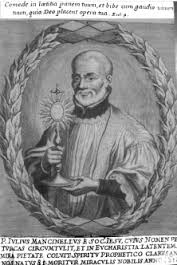Giulio Mancinelli
Giulio Mancinelli (Latin: Julius Mancinellus) (1537-1618)[2] was 16th and 17th century Jesuit missionary. In 1583 he founded Jesuit mission in Ottoman held Istanbul.
Giulio Mancinelli | |
|---|---|
 1677 painting of Giulio Mancinelli published in Vita magni servi Dei P. Julii Mancinelli | |
| Born | October 13, 1537[1] |
| Died | 1618 |
| Other names | Julius Mancinellus |
| Occupation | Jesuit missionary |
Early life
Mancinelli was born to a noble family.[3] He joined the Jesuits in 1558[3] and in 1566 was a novice in the first novitiate house in Rome.[4]
Missionary appointments
Mancinelli was a missionary in Bosnia and Dalmatia.[5] Mancinellus was the head of a Jesuit mission to Istanbul established by the Pope in 1583.[6] They held their services in the Church of Saint Benoit and opened their schools with the support of French and Venetian ambassadors.[7]
In the period between 1585 and 1587 Mancinelli traveled from Constantinople through Wallachia and Moldova, visited Lvov (then in the Crown of the Kingdom of Poland and the Grand Duchy of Lithuania, now in Ukraine, and later Kraków, Crown of the Kingdom of Poland and the Grand Duchy of Lithuania. Having journeyed as far as Russia, he then returned to Italy via Vienna, where he spent a few months.[8]
In 1592 he was sent to Algiers, in response to a request made to the Jesuits by the government of Naples, in order to redeem the Christian slaves: he wrote a memorial of this journey in Morea (Rome, Archivum Romanum Societatis Iesu, Vitae, 46 , cf. 68-83) and in" Observations about redeeming Christian slaves from Servitude to Unbelievers" (ibid., Vitae, 51, cc. 43r-45r). He experienced a supernatural ecstasy during the trip---saints and angels appeared to him to reassure him about the positive outcome of the mission to Moldova---and he recorded his observations.[9]
In 1608, he was on mission in England and according to his own testimonies had visions of angels.[10] In his old age he was regularly consulted by young men who traveled to England hoping to bring it back to union with Rome.[11]
References
- Deresiński, Wojciech (2010). "Mancinelli". Mancinelli informator. Mancienlli Society. 5. Retrieved 25 May 2016.
- Fabre 2008, p. 177: " glulio mancinelu (1537-1618) "
- Coulton 1950, p. 750.
- The Month. 1941. p. 362.
- Deresiński, Wojciech (2010). "Mancinelli". Mancinelli informator. Mancienlli Society. 5. Retrieved 25 May 2016.
- Frazee 2006, p. 74.
- Darnault, Sezim Sezer; Birkan, Çelen (2004). Latin Catholic Buildings in Istanbul: A Historical Perspective, 1839-1923. Isis. p. 45. ISBN 978-975-428-275-7.
- http://www.treccani.it/enciclopedia/giulio-mancinelli_(Dizionario-Biografico)/
- Pozsony, Ferenc; Csermely, Peter (2006). The Hungarian Csángó of Moldova. Corvinus Publishing. p. 82. ISBN 978-1-882785-18-6.
- Marystone, Cyril (1963). The Coming Type of the End of the World and the Universal Conversion of the Nations. o.V. p. 287.
- The Month. 1941. p. 363.
Sources
- Fabre, Pierre-Antoine (2008). Escrituras de la modernidad: los jesuitas entre cultura retórica y cultura científica. Universidad Iberoamericana. ISBN 978-607-417-030-6.CS1 maint: ref=harv (link)
- Frazee, Charles A. (2006) [1983]. Catholics and Sultans: The Church and the Ottoman Empire 1453-1923. Cambridge: Cambridge University Press.CS1 maint: ref=harv (link)
- Coulton, G.G. (1950). Five Centuries of Religion. CUP. p. 750. GGKEY:881G3EASSLN.CS1 maint: ref=harv (link)
External links
- MANCINELLI, Giulio, author Anna Rita Capoccia
Further reading
- Julije Mancinelli o dubrovačkoj okolici (1575/76) /Julius Mancinelli about the Surroundings 'of Dubrovnik (1575/76), XVI (1986) 133-151. BUDIŠA, Dražen